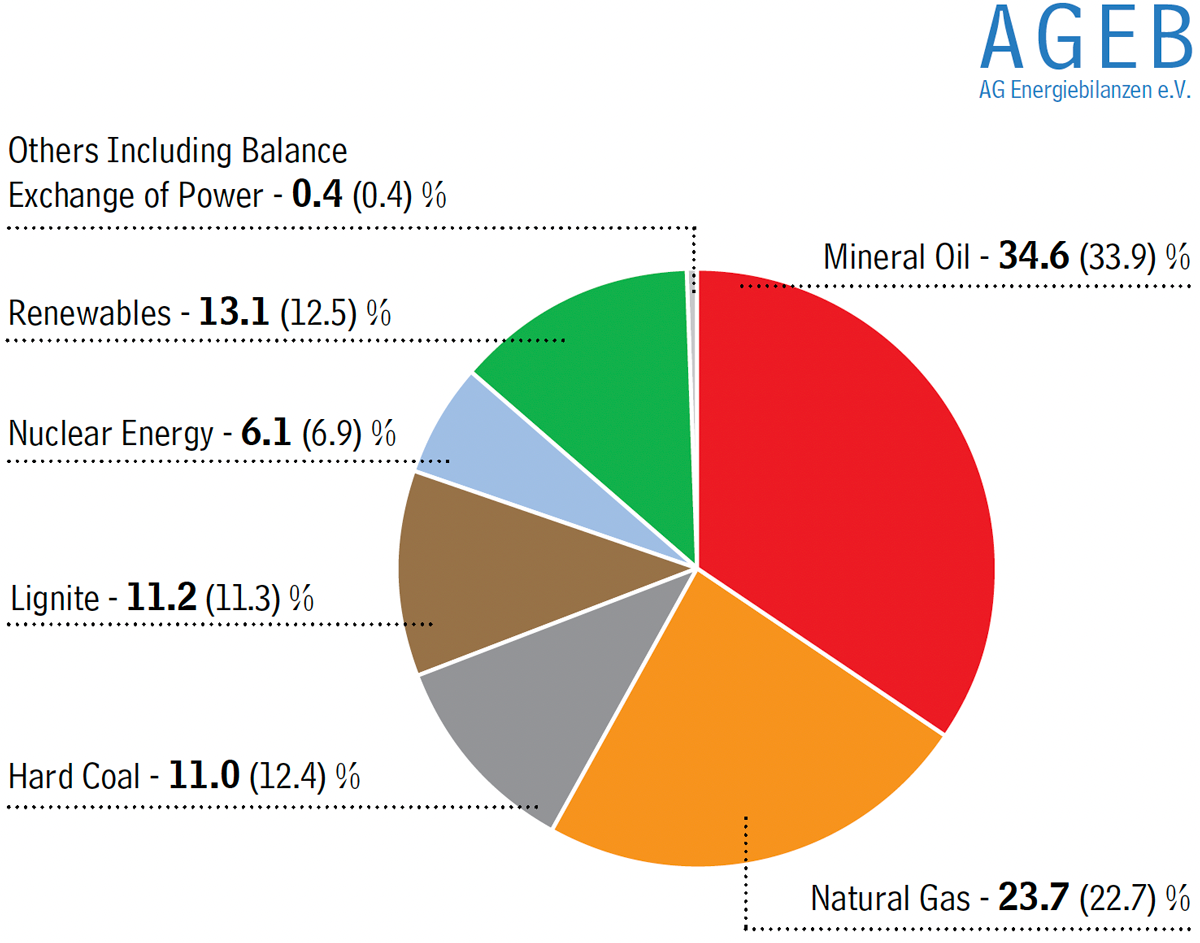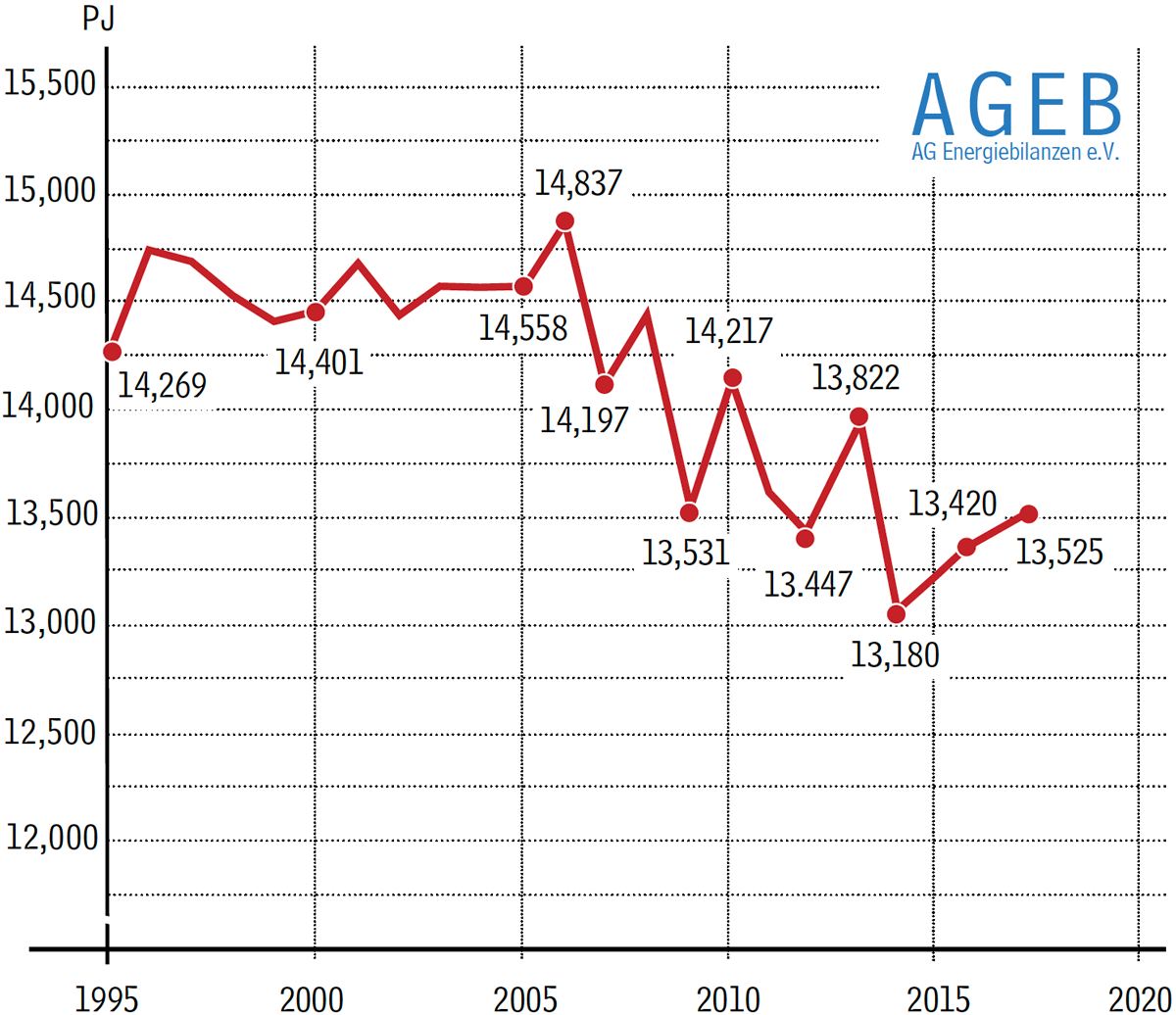Berlin/Bergheim (December 21, 2017) – In 2017, Germany’s energy consumption amounted to a total of 13,525 petajoules (PJ), or 461.5 million tons of coal equivalent (Mtce); it was, thus, 0.8 percent higher than the previous year. According to preliminary calculations conducted by the Arbeitsgemeinschaft Energiebilanzen (AG Energiebilanzen) – Working Group on Energy Balances (Energy Balances Group), increases were recorded for the consumption of mineral oil and natural gas while coal and nuclear energy exhibited a downturn. Renewables were able to substantially augment, in part, their contribution. The increase in consumption is primarily due to the positive economic trend. When it comes to renewables, good wind conditions both on land and off shore, a slightly higher number of sunshine hours, and the construction of additional wind turbines essentially ensured that more electricity was fed into the grid. For energy-related CO₂ emissions, the AG Energiebilanzen anticipates a stagnating development.
Mineral oil consumption in Germany increased by a total of 3 percent to 4,675 PJ (159.5 Mtce) in 2017. This development was, above all, a result of the increased fuel consumption. Gasoline and diesel fuel exhibited a plus of about 2 percent respectively. The consumption of aviation fuel only went up slightly by 0.7 percent. Sales of light fuel oils recorded an increase of about 2 percent while supplies of naphtha to the chemical industry increased by slightly more than 7 percent.
Natural gas consumption peaked at 3,200 PJ (109.2 Mtce) and was, thus, 5.2 percent higher than the previous year. This development was influenced to a large extent by the increased use of natural gas in power plants for the generation of power and heat. Due to the comparably cooler weather during individual months of the previous year, the use of natural gas for heating purposes also recorded an upswing. Industry also used more natural gas for the generation of power and heat.
Hard coal consumption decreased by 10.4 percent and peaked at a total of 1,489 PJ (50.8 Mtce). Displacement effects occurred in power generation because more electricity produced from renewables was fed into the grid and more power was generated in natural gas fired cogeneration plants. In addition, several hard coal fired power plants were taken off the grid. The iron and steel industry increased its use of coal and coke slightly by approximately 0.6 percent.
Lignite consumption fell 0.6 below the previous year’s result and peaked at 1,510 PJ (51.5 Mtce). A reduced use in the existing power plants, which are supplied with about 90 percent of the lignite extracted in Germany, as well as the transfer of the first power plant units into their four year standby mode for backup purposes caused power generation from lignite to decline by 1 percent to 148 terawatt hours in 2017.
Due to power plant overhauls, nuclear energy recorded a minus of 10.3 percent. All told, nuclear energy still contributed a share of 828 PJ (28.3 Mtce) to the energy balance in 2017.
Renewables enhanced their contribution to the total energy consumption in 2017 by more than 6 percent, whereby the individual forms of energy exhibited different trends: Due to the weather conditions and compared to the previous year, power generation from hydro power (excluding pumped storage) decreased by about 4 percent. The electricity which was produced by wind turbines and fed into the grid, however, increased significantly by 34 percent. Solar energy (solar heat and PV power) exhibited an increase of 5 percent. Geothermal energy recorded an overall plus of 7 percent. Biomass and waste stagnated at the previous year’s level. The proportion of renewables of Germany’s total energy consumption increased to
13.1 percent in 2017.
Compared to the previous year, the contributions of the diverse energy sources to the national energy mix have shifted further in 2017: Mineral oil and natural gas as well as renewables were able to increase their shares in the energy consumption. Nuclear energy and hard coal exhibited significant and lignite slight declines. All told, the German energy supply is based on a broad mix of available energy sources. Oil and gas account for almost 60 percent of the domestic energy consumption. Hard coal and lignite together covered slightly more than one fifth of the consumption.
Renewables are continuously increasing their overall contribution.
Energy Consumption in 2017
Development of Primary Energy Consumption in Germany in 2017 Change in Percent – Total 13,525 PJ or 461.5 Mtce

Berlin/Bergheim — In 2017, primary energy consumption in Germany was almost 1 percent above the previous year’s level. According to preliminary calculations conducted by the Arbeitsgemein- schaft Energiebilanzen (AG Energiebilanzen) – Working Group on Energy Balances (Energy Balances Group), consumption peaked at 13,525 petajoules (PJ), which translates into 461.5 million tons of coal equivalent (Mtce).
Energy Mix with a Higher Share of Renewables
Structure of Primary Energy Consumption in Germany in 2017 Total Volume 13,525 PJ or 461.5 Mtce
Proportion in Percent (Previous Year in Parentheses)

Berlin/Bergheim – The contributions of the diverse energy sources to the national energy mix have shifted further in 2017 when compared to the previous year. Mineral oil and natural gas as well as renewables were able to increase their shares in the energy consumption. Nuclear energy and hard coal exhibited significant and lignite slight declines. All told, the German energy supply is based on a broad mix of available energy sources. Oil and gas account for almost 60 percent of the domestic energy consumption. Renewables continued to expand their relevance. Hard coal and lignite together covered slightly more than one fifth of the consumption.
Source: AG Energiebilanzen
Primary Energy Consumption in Germany
1995 — 2017
in Petajoules (PJ)

Berlin/Bergheim – Energy consumption in Germany increased moderately once again in 2017. This increase was primarily due to the continued positive economic development. When compared to previous years, overall consumption was all told at a low level.
Source: AG Energiebilanzen
